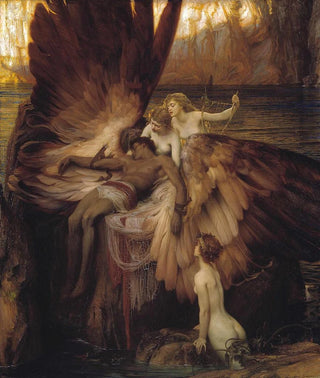Art print | The Lament for Icarus - Herbert James Draper


View from behind

Frame (optional)
In a world where art blends with mythology, "The Lament for Icarus" by Herbert James Draper stands out as an iconic work, evoking tragedy and the beauty of a doomed destiny. This painting captures the moment when Icarus, son of Daedalus, faces the consequences of his daring, inviting us to reflect on themes of ambition, downfall, and human resilience. Draper, with his unparalleled talent, succeeds in translating a profound emotion onto the canvas, blending the lightness of Icarus's wings with the heaviness of his failure. This tableau, a true ode to Greek mythology, serves as a mirror to human aspirations, reminding us that the pursuit of freedom can sometimes lead to dizzying falls.
Style and uniqueness of the work
The stylistic richness of "The Lament for Icarus" lies in its harmonious blend of realism and symbolism. Draper uses vibrant colors and striking contrasts to bring his characters to life. The composition is carefully orchestrated, with each element placed with a masterful precision. The drapery of the clothing, the texture of the wings, and Icarus's facial expression all demonstrate the artist's technical mastery. The background, both majestic and unsettling, enhances the sense of despair emanating from the scene. Light plays a crucial role, subtly illuminating Icarus's body while casting the rest of the canvas into a heavy shadow. This duality between light and darkness symbolizes the struggle between aspiration and reality, creating a palpable tension that captivates the viewer.
The artist and his influence
Herbert James Draper, a key figure in early 20th-century British painting, established himself through his unique style and his ability to combine technique and emotion. Influenced by the great masters of the past, such as Botticelli and Michelangelo, Draper reinterpreted classical themes with modern sensitivity. His work is marked by a fascination with mythology, which he explores with rare depth. By tackling timeless subjects

Matte finish

View from behind

Frame (optional)
In a world where art blends with mythology, "The Lament for Icarus" by Herbert James Draper stands out as an iconic work, evoking tragedy and the beauty of a doomed destiny. This painting captures the moment when Icarus, son of Daedalus, faces the consequences of his daring, inviting us to reflect on themes of ambition, downfall, and human resilience. Draper, with his unparalleled talent, succeeds in translating a profound emotion onto the canvas, blending the lightness of Icarus's wings with the heaviness of his failure. This tableau, a true ode to Greek mythology, serves as a mirror to human aspirations, reminding us that the pursuit of freedom can sometimes lead to dizzying falls.
Style and uniqueness of the work
The stylistic richness of "The Lament for Icarus" lies in its harmonious blend of realism and symbolism. Draper uses vibrant colors and striking contrasts to bring his characters to life. The composition is carefully orchestrated, with each element placed with a masterful precision. The drapery of the clothing, the texture of the wings, and Icarus's facial expression all demonstrate the artist's technical mastery. The background, both majestic and unsettling, enhances the sense of despair emanating from the scene. Light plays a crucial role, subtly illuminating Icarus's body while casting the rest of the canvas into a heavy shadow. This duality between light and darkness symbolizes the struggle between aspiration and reality, creating a palpable tension that captivates the viewer.
The artist and his influence
Herbert James Draper, a key figure in early 20th-century British painting, established himself through his unique style and his ability to combine technique and emotion. Influenced by the great masters of the past, such as Botticelli and Michelangelo, Draper reinterpreted classical themes with modern sensitivity. His work is marked by a fascination with mythology, which he explores with rare depth. By tackling timeless subjects






